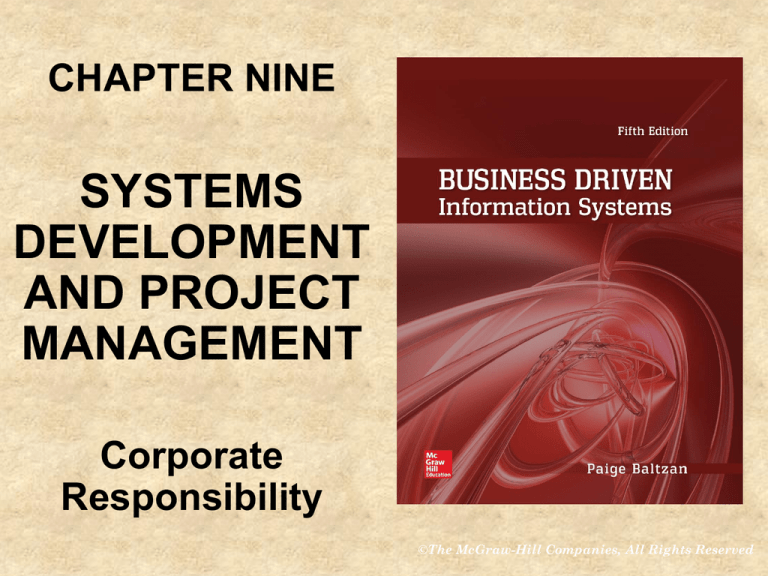
CHAPTER NINE
SYSTEMS
DEVELOPMENT
AND PROJECT
MANAGEMENT
Corporate
Responsibility
©The McGraw-Hill Companies, All Rights Reserved
2
CHAPTER OVERVIEW
SECTION 9.1 – Developing Enterprise
Applications
•
•
•
•
The Systems Development Life Cycle
Software Development Methodology: Waterfall
Agile Software Development Methodologies
Service-Oriented Architectures
SECTION 9.2 – Project Management
•
•
•
•
Using Project Management to Deliver Successful Projects
The Elements of Project Planning
Primary Project Planning Diagrams
Outsourcing Projects
SECTION 9.1
Developing
Enterprise
Applications
©The McGraw-Hill Companies, All Rights Reserved
4
LEARNING OUTCOMES
1. Describe the seven phases of the
systems development life cycle
2. Summarize the different software
development methodologies
3. Explain why a company would implement
a service-oriented architecture
5
THE SYSTEMS DEVELOPMENT
LIFE CYCLE
Software that is built correctly can transform
as the organization and its business
transforms
Software that effectively meets employee
needs will help an organization become more
productive and enhance decision making
Software that does not meet employee needs
may have a damaging effect on productivity
and can even cause a business to fail
6
THE SYSTEMS DEVELOPMENT
LIFE CYCLE
As organizations’ reliance on software grows,
so do the business-related consequences of
software successes and failures including:
• Increase or decrease revenue
• Repair or damage to brand reputation
• Prevent or incur liabilities
• Increase or decrease productivity
7
THE SYSTEMS DEVELOPMENT
LIFE CYCLE
Systems
development life
cycle (SDLC) – The
overall process for
developing
information systems
from planning and
analysis through
implementation and
maintenance
8
THE SYSTEMS DEVELOPMENT
LIFE CYCLE (SDLC)
1. Planning phase – Establishes a high-level
plan of the intended project and determines
project goals
2. Analysis phase – Involves analyzing enduser business requirements and refining
project goals into defined functions and
operations of the intended system
9
THE SYSTEMS DEVELOPMENT
LIFE CYCLE (SDLC)
3. Design phase – Establishes
descriptions of the desired features
and operations of the system
including screen layouts, business
rules, process diagrams, pseudo
code, and other documentation
4. Development phase – Involves
taking all of the detailed design
documents from the design phase
and transforming them into the
actual system
10
THE SYSTEMS DEVELOPMENT
LIFE CYCLE (SDLC)
5. Testing phase – Involves bringing all the
project pieces together into a special testing
environment to eliminate errors and bugs, and
verify that the system meets all of the
business requirements defined in the analysis
phase
6. Implementation phase – Involves placing the
system into production so users can begin to
perform actual business operations with it
11
THE SYSTEMS DEVELOPMENT
LIFE CYCLE (SDLC)
7. Maintenance phase – Involves
performing changes, corrections,
additions, and upgrades to ensure the
system continues to meet its business
goals
12
SOFTWARE DEVELOPMENT
METHODOLOGIES
There are a number of different
software development
methodologies including
•
•
•
•
•
•
Waterfall
Agile
Rapid application development
(RAD)
Extreme programming
Rational unified process (RUP)
Scrum
13
Waterfall Methodology
Waterfall
methodology – A
sequence of
phases in which
the output of each
phase becomes
the input for the
next
14
Agile Methodology
Iterative development –
Consists of a series of tiny
projects
Agile methodology – Aims for
customer satisfaction through
early and continuous delivery of
useful software components
developed by an iterative
process using the bare
minimum requirements
15
Rapid Application Development
Methodology (RAD)
Rapid application development methodology–
Emphasizes extensive user involvement in the
rapid and evolutionary construction of working
prototypes of a system to accelerate the systems
development process
Prototype – A smaller-scale representation or
working model of the users’ requirements or a
proposed design for an information system
The prototype is an essential part of the analysis
phase when using a RAD methodology
16
Extreme Programming
Methodology
Extreme programming (XP) methodology – Breaks a
project into tiny phases, and developers cannot continue on
to the next phase until the first phase is complete
17
Rational Unified Process (RUP)
Methodology
Rational Unified Process (RUP) – Provides a
framework for breaking down the development of
software into four gates
• Gate One: Inception
• Gate Two: Elaboration
• Gate Three: Construction
• Gate Four: Transition
18
SCRUM Methodology
SCRUM – Uses small teams to produce small
pieces of deliverable software using sprints, or
30-day intervals, to achieve an appointed goal
Under this methodology, each day ends or
begins with a stand-up meeting to monitor and
control the development effort
19
DEVELOPING A SERVICEORIENTED ARCHITECTURE
• Service-oriented architecture (SOA) is a business-driven
enterprise architecture that supports integrating a business
as linked, repeatable activities, tasks, or services.
SECTION 9.2
Project
Management
©The McGraw-Hill Companies, All Rights Reserved
21
LEARNING OUTCOMES
4. Explain project management and the
primary reasons project fail
5. Identify the primary project planning
diagrams
6. Identify the three different types of
outsourcing along with their benefits and
challenges
22
USING PROJECT MANAGEMENT TO DELIVER
SUCCESSFUL PROJECTS
Primary reasons for project failure
•
•
•
•
•
Unclear or missing business requirements
Skipping SDLC phases
Failure to manage project scope
Scope creep
Feature creep
Failure to manage project plan
Changing technology
23
USING PROJECT MANAGEMENT TO DELIVER
SUCCESSFUL PROJECTS
24
USING PROJECT MANAGEMENT TO DELIVER
SUCCESSFUL PROJECTS
25
USING PROJECT MANAGEMENT TO DELIVER
SUCCESSFUL PROJECTS
26
USING PROJECT MANAGEMENT TO DELIVER
SUCCESSFUL PROJECTS
The later in the SDLC an error is found the more
expensive it is to fix!
27
USING PROJECT MANAGEMENT TO DELIVER
SUCCESSFUL PROJECTS
Analysts predict investment in MIS projects
worldwide is over $1 trillion
70 percent will be lost due to failed projects
The consequences of failed projects include
•
•
•
•
•
Damaged brand
Lost goodwill
Dissolution of partnerships
Lost investment opportunities
Low morale
28
USING PROJECT MANAGEMENT TO DELIVER
SUCCESSFUL PROJECTS
The Project Management Institute (PMI) develops
procedures and concepts necessary to support the
profession of project management (www.pmi.org)
and has three areas of focus
1. The distinguishing characteristics of a practicing
professional (ethics)
2. The content and structure of the profession’s body of
knowledge (standards)
3. Recognition of professional attainment (accreditation)
29
The Triple Constraint
Benjamin Franklin’s timeless advice - by failing to
prepare, you prepare to fail - applies to software
development projects
The Hackett Group analyzed 2,000 companies and
discovered
• Three in 10 major IT projects fail
• 21 percent of the companies state that they cannot
adjust rapidly to market changes
• One in four validates a business case for IT projects
after completion
30
The Triple Constraint
Project Management Interdependent Variables
31
USING PROJECT MANAGEMENT TO DELIVER
SUCCESSFUL PROJECTS
Project – Temporary activities undertaken to
create a unique product or service
Project management – The application of
knowledge, skills, tools, and techniques to
project activities to meet project requirements
Project manager – An individual who is an
expert in project planning and management,
defines and develops the project plan, and
tracks the plan to ensure the project is
completed on time and on budget
32
USING PROJECT MANAGEMENT TO DELIVER
SUCCESSFUL PROJECTS
Project deliverable – Any measurable,
tangible, verifiable outcome, result, or item that
is produced to complete a project or part of a
project
Project milestone – Represents key dates
when a certain group of activities must be
performed
Project management office (PMO) – An
internal department that oversees all
organizational projects
33
Project Participants
Project stakeholder - Individuals and
organizations actively involved in the project or
whose interests might be affected as a result of
project execution or project completion
Executive sponsor - The person or group who
provides the financial resources for the project
34
PRIMARY PROJECT PLANNING
DIAGRAMS
SMART criteria are
useful reminders on
how to ensure that
the project has
created
understandable and
measurable
objectives
35
PRIMARY PROJECT PLANNING
DIAGRAMS
Project plan – A formal, approved document
that manages and controls project execution
A well-defined project plan should be
•
Easy to understand and read
•
Communicated to all key participants
•
Appropriate to the project’s size, complexity, and
criticality
•
Prepared by the team, rather than by the individual
project manager
36
PRIMARY PROJECT PLANNING
DIAGRAMS
Two primary diagrams used in project
planning include PERT and Gantt charts
•
PERT chart
Dependency
Critical path
•
Gantt chart
37
PRIMARY PROJECT PLANNING
DIAGRAMS
PERT Chart EXPERT – PERT Chart Example
38
PRIMARY PROJECT PLANNING
DIAGRAMS
MS Project – Gantt Chart Example
39
OUTSOURCING PROJECTS
In-sourcing (in-housedevelopment) –Uses the
professional expertise within an
organization to develop and maintain
its information technology systems
Outsourcing – An arrangement by
which one organization provides a
service or services for another
organization that chooses not to
perform them in-house
40
OUTSOURCING PROJECTS
Factors driving outsourcing growth include
•
•
•
•
Core competencies
Financial savings
Rapid growth
The Internet and globalization
41
OUTSOURCING PROJECTS
Onshore outsourcing
Nearshore outsourcing
Offshore outsourcing
42
OUTSOURCING PROJECTS
Big selling point for offshore outsourcing
“inexpensive good work”
43
Outsourcing Benefits
Outsourcing benefits include
• Increased quality and efficiency of business processes
• Reduced operating expenses for head count and
exposure to risk for large capital investments
• Access to outsourcing service provider’s expertise,
economies of scale, best practices, and advanced
technologies
• Increased flexibility for faster response to market changes
and less time to market for new products or services
44
Outsourcing Challenges
Outsourcing challenges include
•
Length of contract
1. Difficulties in getting out of a contract
2. Problems in foreseeing future needs
3. Problems in reforming an internal IT department
after the contract is finished
•
Threat to competitive advantage
•
Loss of confidentiality
45
LEARNING OUTCOME REVIEW
Now that you have finished the chapter
please review the learning outcomes in
your text






